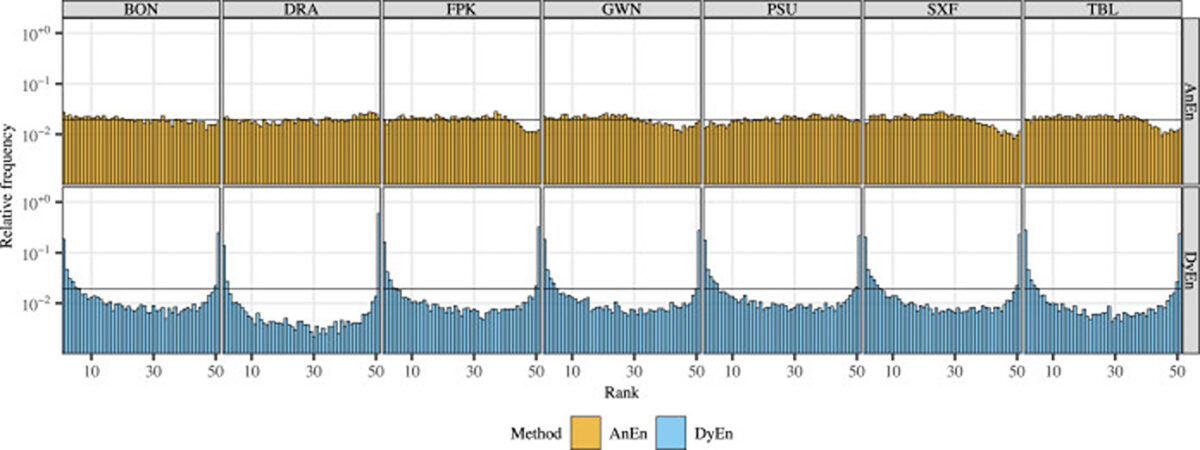A group of researchers in China investigated the reliability of analog ensemble (AnEn) forecasting and dynamical ensemble (DyEn) forecasting for PV power generation and found both technologies offer advantages and disadvantages.
Ensemble techniques are commonly used in weather forecasting and are known for generating a set of forecasts instead of the most likely weather scenario. “AnEn operates under the principle that weather patterns often repeat, while DyEn generates equally likely trajectories of future weather by perturbing the initial and boundary conditions. They constitute the two most common approaches to making ensembles,” the scientists explained.
For their investigation, the research group used four years of forecasts generated by the European Centre for Medium-Range Weather Forecasts (ECMWF) from the beginning of 2017 to the end of 2022. Data were taken from seven points in the United States and compared to radiometry measurements collected in the seven stations of the Surface Radiation Budget Monitoring (SURFRAD).
The locations were Bondville, Illinois; Desert Rock, Nevada; Fort Peck, Montana; Goodwin Creek, Mississippi; Pennsylvania State University, Pennsylvania; Sioux Falls, South Dakota; and Table Mountain, Colorado. The scientists processed the date using both the AnEn and DyEn forecasting in raw form and then applied three post-processing methods: Bayesian model averaging (BMA), nonhomogeneous Gaussian regression (NGR), and quantile regression (QR).
“It should be noted that comparing just the raw AnEn and DyEn forecasts has little practical relevance, because probabilistic-to-probabilistic (P2P) post-processing has long been recognized as an integral part of the solar forecasting process,” the academics specified. “One of the goals of P2P post-processing is to improve calibration, which constitutes one of the two types of goodness of probabilistic forecasts, with the other one being sharpness.”
Popular content
The analysis showed that the raw AnEn technique can achieve better calibration than the raw DyEn, with average reliability values of 0.6 W/m2 and 8.2 W/m2, respectively. However, DyEn was better after post-processing, showing an average continuous ranked probability score of 49.0 W/m2, compared to 51.7 W/m2 obtained by AnEn.
“The raw AnEn forecasts outperform the raw DyEn due to their better calibration; however, after calibration, the potentially poor-quality analogs introduce noises into the post-processing models and thus limit their performance, whereas the DyEn forecasts are generated using the same numerical weather prediction (NWP) model, and therefore have better model-consistency that is conducive to bias-correction and spread adjustment,” the researchers added.
They also found that calibration via BMA and NGR is less suitable for both AnEn and DyEn. QR, on the other hand, “emerges as the most appealing option,” said the scientists.
The findings were presented in “Comparing calibrated analog and dynamical ensemble solar forecasts,” published in Solar Energy Advances. The research team comprises researchers from Harbin Institute of Technology and the State Grid Corporation of China.
This content is protected by copyright and may not be reused. If you want to cooperate with us and would like to reuse some of our content, please contact: editors@pv-magazine.com.


By submitting this form you agree to pv magazine using your data for the purposes of publishing your comment.
Your personal data will only be disclosed or otherwise transmitted to third parties for the purposes of spam filtering or if this is necessary for technical maintenance of the website. Any other transfer to third parties will not take place unless this is justified on the basis of applicable data protection regulations or if pv magazine is legally obliged to do so.
You may revoke this consent at any time with effect for the future, in which case your personal data will be deleted immediately. Otherwise, your data will be deleted if pv magazine has processed your request or the purpose of data storage is fulfilled.
Further information on data privacy can be found in our Data Protection Policy.